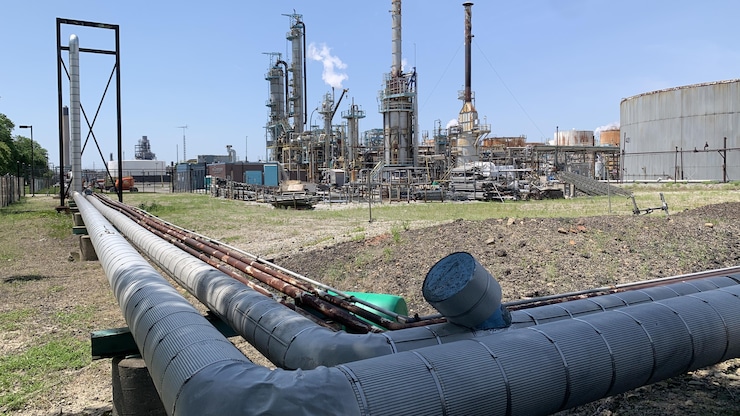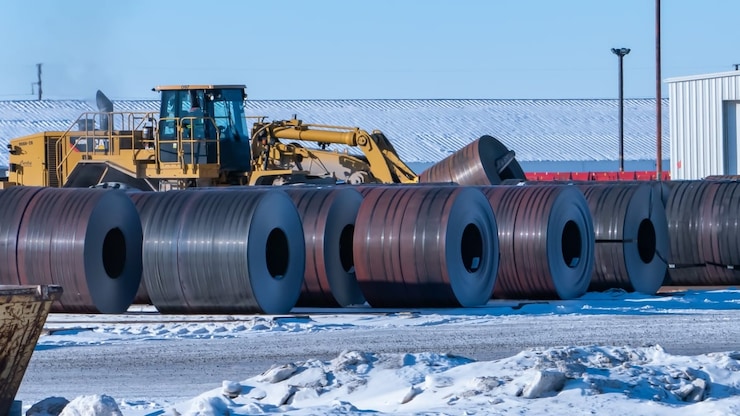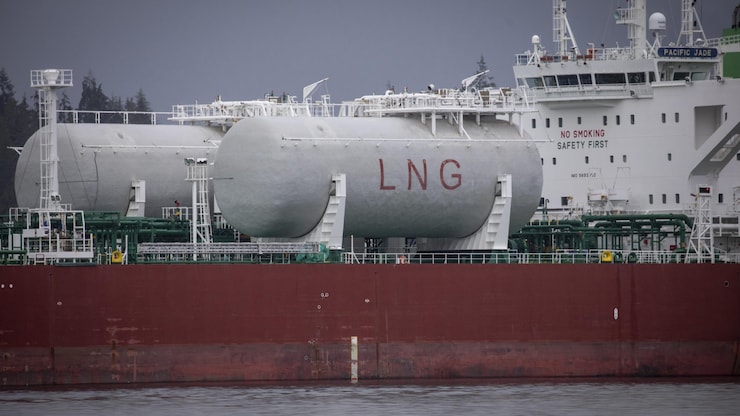Canada News
Trump’s threats reveal the trouble with Canada’s pipelines running through the U.S.
By Evan Dyer, CBC News, RCI

The Westridge Marine Terminal at the Port of Vancouver handles crude oil exports to global markets. If Canada were to avoid pipelines that run through U.S. territory, the Trans Mountain Expansion is the best of the country’s limited options. (Gian Paolo Mendoza/CBC) Photo: (Gian Paolo Mendoza/CBC)
Interconnectedness is a double-edged sword and Canada is vulnerable in any trade war
Continental energy security
was the watchword of both governments and industry for much of the past quarter century in North America: the idea that by linking the U.S. and Canada in a tight web of pipelines and refineries, both countries would protect themselves from threats and hostile trade actions that — it was assumed — would come from outside North America.
The website of the Canadian Association of Petroleum Producers is still littered with references (new window) to the now-obsolete notion that increasing interdependence with the U.S. would make Canada safer: Over the past decade, Canada has strengthened its continental energy security by reducing reliance on overseas oil and increasing the share of imports from the United States.
Too late did Canada realize that the threat would come from inside the house — that Americans would elect a president who saw Canada not as a partner, but as a target for extortion and even annexation (new window).

Alberta can supply the volume of oil Sarnia, Ont., needs for its refineries. But that oil flows through pipelines that cut through the U.S. Photo: Radio-Canada / Elvis Nouemsi Njiké
In the days when the Enbridge mainline (new window) was being laid down, talk of trying to keep infrastructure within Canada was dismissed as expensive and unnecessary, said oil market analyst Rory Johnston, founder of the Commodity Context newsletter and a lecturer at the University of Toronto’s Munk School of Global Affairs.
If it’s easier to push a pipeline through the U.S. border, if it’s cheaper, if there’s less political blowback than going through B.C. or Quebec, well it was a no-brainer, because the United States, our closest ally through all of history, would never impose a punitive tariff on us. That’s crazy talk.
And yet here we are.
All eggs in one basket
There was never serious consideration to the reverse of that,
Johnston told CBC News. No other oil exporter on the planet has the same kind of built-in constraints.
Had they foreseen the rise of MAGA, says Johnston, no industry in its right mind would have created this kind of dependence on the U.S. market.
Ironically, the very pipelines built in the name of continental energy security are now potential weapons in a trade war between the two erstwhile allies.
American reliance on Canadian heavy crude is the most powerful economic weapon in Canada’s arsenal. But the same network also gives the U.S. leverage over Canada.
Were Canada ever to reach for its nuclear option
— placing export tariffs on Canadian energy or even threatening to cut off supply — it would risk shortages of crude and refined fuels in other regions of the country.
‘A very extreme move’
Calgary-based energy security analyst Joe Calnan said such a move would certainly put pressure on the U.S.
“It’s going to be very, very difficult (new window) for the United States to replace Canadian heavy oil supply,” he said.
But there’s a question of whether it’s going too far. We need to be frank here that this would be a very extreme move to actually cut off oil. And we should anticipate a very strong political response from the United States if that ends up being the path we go down.
The key point of Canadian vulnerability begins in Gretna, Man., where the Enbridge main pipeline carrying Albertan oil east crosses into the U.S. In Superior, Wis., the line bifurcates, with most of the crude continuing south to the huge refining hub around Chicago. Line 5 swings east, across the U.S. part of Lake Superior, and then across Michigan until it re-enters Canada to end at the refining hub of Sarnia, Ont.
Calnan says the U.S. has the technical ability to shut off the flow of Western Canadian oil to Ontario.

When much of Canada’s oil pipelines were installed, the concept of ‘continental energy security’ seemed much more secure than it does now. (Rob Kruk/CBC) Photo: (Rob Kruk/CBC)
About half a million barrels of oil travel through Line 5 every day. Another half-million reach Sarnia from Pontiac, Ill., through Line 78, some of it heavy crude from Alberta, and some light crude from North Dakota.
Alberta can supply the volume of oil Sarnia needs. The problem would be getting it there without Line 5 or Line 78. Replacing that with trucks or rail is a big challenge,
said Calnan, adding that safety measures implemented after the Lac-Mégantic train disaster (new window) have made it even more difficult to move oil by rail.
I’m not saying that it’s completely impossible,
said Calnan, but it would be very expensive.
Rules no longer matter
Closing flow through Lines 5 and 78 to Sarnia would violate the 1977 Canada-U.S. Pipeline Treaty, which binds each country not to impede the flow of the other country’s oil through its national territory.
But some experts believe that would matter little to Trump.
The imposition of tariffs is itself a violation of [CUSMA],
said Johnston. So I think the rules are off. And I think the concrete geopolitics of Albertan crude having to pass through the U.S. in order to get to Sarnia is a very real constraint.
Sarnia’s refineries already narrowly avoided shutdown when the State of Michigan in 2020 sought to have Line 5 closed (new window) for environmental reasons.
Both Enbridge and the Government of Canada counter-sued, the latter citing the 1977 treaty (new window), and the pipeline stayed open. But it was an early wake-up call to Central Canada’s vulnerability.
Ontario the most vulnerable
Atlantic Canada is protected by being separated from the main North American oil network. Johnston says Quebec refineries would face challenges, but could probably bring offshore oil from the east.
But Ontario would be Canada’s Achilles heel in any oil war, says Johnston.
Line 9 (new window), which flows east from Sarnia to refineries in the Montreal area, could become critical in a real trade war with the U.S.
The 832-kilometre pipeline encapsulates the history of Canada-U.S. mutual dependency. When it started operations in 1976, it carried Alberta oil east. Twenty years later, the economics were changing and there were fears that North American oil would run out. So in 1998 the flow was reversed; now the pipeline would carry overseas crude — shipped by tankers — from the Port of Montreal to Sarnia.
But a decade after that, the U.S. shale oil boom began, and fears of scarcity evaporated. Now continental energy security
was in, OPEC oil was out and in 2012 Line 9 switched back to west-east.
By reversing flow a third time, Canada could potentially mitigate the effects of a shutdown of Line 5 and 78, buying oil overseas and importing it in tankers.
But those would be drastic and expensive measures, and Johnston says Ontario could still expect at least short-term shortages.
Shortages at the gas pump
Indeed, the problem is not merely oil, but rather the main finished products made from oil: gasoline and diesel.
Canada uses about 2.4 million barrels of oil a day, but only has the domestic capacity to refine about 1.9 million. It would be complicated to source the half-million barrels of refined product from overseas.
The refining gap is another reminder of Canada’s vulnerability as a one-time partner turns unpredictable and unreasonable, and an additional reason, say the experts, why Canada should try to avoid an all-out oil supply war and instead focus on lessening Canada’s long-term exposure to U.S. attempts to extort concessions.
That means new pipelines to new markets — an idea that is rapidly gaining ground (new window) after years of stalemate.
Without the Trans Mountain Expansion (TMX) that can carry about 900,000 barrels of Alberta crude to the Port of Vancouver, says Johnston, we would be in a whole world of hurt right now, even before the tariffs hit.
TMX, which began operating in May and has given Albertan oil an outlet to Asian markets, has brought the price “differential (new window)” on Alberta oil (the discount demanded by U.S. refiners to handle heavy, sour crude rather than light, sweet crude) to a historic low.
TMX came just in time
We would probably be back at $25, almost $30-a-barrel differentials today even without the tariffs if we didn’t have TMX,
Johnston told CBC News. The Trudeau government deserves some credit for building that pipeline, he says, but it’s hard to argue that Ottawa really went to bat for the oilpatch.
My hope is that this has recentred the strategic value of Western Canadian production in the minds of Eastern Canadians, in the minds of politicians in Ottawa to understand there has to be some give and take. Maybe there is some grand east-west bargain that can be reached.

The oil tanker Pacific Jade is seen leaving the Port of Vancouver. Alberta oil shipped from B.C. has opened up Asian markets to Canada. (Ben Nelms/CBC) Photo: Radio-Canada / Ben Nelms
That bargain involves committing to give Alberta new pipelines in exchange for Alberta agreeing to take a hit in any trade war with the Trump administration.
In the short term, says Calnan, TMX could probably provide more relief to Alberta producers.
I believe they can de-bottleneck a few hundred thousand barrels per day of additional capacity. I don’t think that would take very long. You’d want to increase the number of pump stations along it, increase the pressure. You could also do some dredging operations so you can fill the ships a bit more,
he said.
You can unlock that pretty easily if there’s real political will.
In the long run, though, Calnan says Canada should both add new capacity to TMX and revive the Energy East pipeline project that would allow Alberta oil to flow to Ontario without ever leaving Canada.
As a quid pro quo, he says, Ottawa could ask Alberta to do something it already did in 2018 (new window) in response to brutal price differentials on Canadian oil at U.S. refineries: curtail (but not cease) production.
Curtailment was widely supported in the oil patch, and though introduced under the NDP government of Rachel Notley, the policy was then maintained by Jason Kenney.
Alberta heavy crude at one point became almost worthless, but prices climbed back and differentials steadily decreased to where they are today — mostly under $10 a barrel. (The differential has fluctuated in recent days as markets have reacted to Trump’s contradictory public musings.)
Don’t try to fight on two fronts
Johnston says Ottawa should avoid a two-front war against both the United States and Alberta,
and seek instead a political agreement where Alberta agrees to short-term pain in return for long-term gain in the form of new pipelines that will also make the whole country less vulnerable to Trump’s extortion.
The way this conversation has already gone has really entrenched people in their positions. And I think we were already off to a very unproductive start,
he said.
WATCH | What would a trade war look like?:
What would a Canada-U.S. tariff war actually look like? | About That
Canada is responding to U.S. President Donald Trump’s threat of massive tariffs on Canadian imports with retaliatory tariffs of its own. Andrew Chang explains how tariffs — and a possible trade war — could impact the economy, businesses, and consumers both north and south of the border. Images gathered from Reuters, Getty Images, and The Canadian Press.
In the event that Trump tariffs Canadian oil, he says, Canada should respond by reducing supply by about 300,000 barrels — an action similar to the 2018 curtailment — while focusing on freeing Canada in the longer term from over-dependency on a neighbour that can no longer be considered a reliable partner.
There has been recent talk (new window) of restarting Northern Gateway, but the idea has been played down by Enbridge itself. Spokesperson Jesse Semko told CBC News this week that the company has no plans
to revisit it.
Nothing would prevent governments from taking on the project, but Johnston says the payoff would be many years away.
It’s probably simpler to add an additional kind of twinning or tripling on TMX than to go through an entire new siting of Northern Gateway,
he said. I think the long and short of it is either a pipeline to the West Coast or a pipeline to the East Coast. Or more realistically both.
This article is republished from RCI.





















